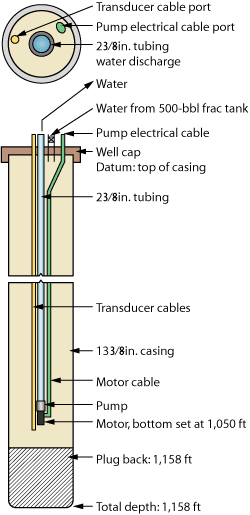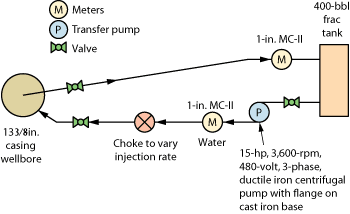New water sensor may allow easy well monitoring
A new sensor detects the downhole fluid level, allowing for easy well monitoring and therefore extending the life of downhole pumps.
A new sensor detects the downhole fluid level, allowing for easy well monitoring and therefore extending the life of downhole pumps.Doug Tunison, Rocky Mountain Oilfield Testing Center; and Brian Houghton, PPS Control
PPS Control’s Accuwire Transducer, a downhole water level sensor for use in oilfield applications, was recently tested at the Rocky Mountain Oilfield Testing Center (RMOTC), located in Teapot Dome Oil Field, also known as Naval Petroleum Reserve No. 3 (NPR-3), near Casper, Wyoming. INTRODUCTION Considering that the majority of US land oil wells are produced through artificial lift, there is an increasing need to easily monitor and analyze the performance of wells. Four days of testing was performed at RMOTC in April 2008. While some initial lab testing had been done, the transducer’s performance downhole was unknown. The tool was tested against proven sensors to better understand its performance characteristics. The results of testing have led to many design improvements that will help move this technology to market. The tests of the downhole sensor were critical to establish its reliability and performance. FIELD TEST The purpose of the field test was to determine the operability and performance of the downhole water sensor specifically in coalbed methane wells, although the technology is designed to work in other oilfield applications. The RMOTC project manager, in consultation with PPS Control, selected Well 86-1-X-10 (Fig. 1) to simulate water production from a 1,000-ft-deep CBM well. The well had casing without any perforations and a cement plug in the bottom at 1,101 ft. This large-diameter (133⁄8-in.) well provided a closed system to perform the test. Water was injected into the wellbore at the surface of the well. The well was completed with production tubing string to run an electrical submersible pump. It was also equipped with electrical cable for the ESP. A wire with a pressure transducer was strapped to the production tubing. The wellhead consisted of hangers for the tubing string, the electrical cable for the pressure gauge and the sensor cable. The water was provided by a 400-bbl tank and a water pump. The fluid level in the well was monitored, as were the injection and production rates and pressures. Figure 2 shows a process flow diagram of the surface equipment. A Grundfos ESP was installed on 23⁄8-in. tubing to a depth of 900 ft. The pressure transducer was installed 3 ft above the pump. The Accuwire cable and sensor were attached to the downhole tubing and the electrical panel at the surface. The water depth was controlled to maintain a varying water column. Fluid was pumped from the well by the ESP to a collection tank on the surface. Produced fluids were returned to the injection side of the system for reuse. The fluid injection, fluid production and backpressure on the well were controlled to provide the test environment needed. A downhole electrical pressure transducer (gauge) was installed on the production tubing string along with the new sensor to verify its performance. The new sensor was designed to work like a downhole pressure level indicator with no downhole electronics. Changes in the fluid level were identified and located using the new sensor, which has an accuracy of ±2% of fluid level in the well with a resolution of 6 in. Calibration measurements were made to optimize the operation of the sensor.
The Accuwire system consists of a special cable that is installed in the wellbore and a small electronic controller that can be conveniently mounted with the pump-controlling equipment on the surface. The controller generates electrical pulses that are sent down the cable. The system measures changes in cable impedance—a measure of opposition to a sinusoidal alternating current. The fluid level information is then converted to a standard 4–20-mA process control format for input into an external pump control. Fluid level information can also be read from the controller using the serial interface. The serial interface is used with a PC to program the well information into the controller during the initial setup. The serial interface uses standard Modbus protocol. Once the system was set up and testing began, comparisons were made between the new sensor and the downhole pressure transducer as the fluid level was varied in the wellbore. These measurements were used to check the calibration, linearity and other performance parameters of the system. The system performed very well, tracking the fluid level to within 2% and showing very good linearity and hysterics characteristics. The testing showed that this would be a highly viable technology and could be brought to production or licensed in a relatively short time and with little capital investment. CONCLUSIONS This test will help improve accuracy and reliability of the technology and has led to some design improvements. This technology could prove to be highly useful to producers. Because all of the electronics on the transducer are outside of the well rather than downhole, maintenance and repair may be easier and more cost-effective. The sensor wire cost may also be much less than pressure transducer cabling, which may allow the producer to achieve a reduction in overall operating costs by adopting this fluid level sensor, allowing marginal fields to be profitable longer. In this case, the downhole sensor will allow for increased recovery of methane gas and lower operating and capital costs. It provides practical, routine, direct measurement of bottomhole pressure, thus providing one of the single most important parameters for well analysis. The data generated on compatibility, signal integrity and run times have enabled PPS Control to improve its product design.
|
|||||||||||||||||||||
- Shale technology: Bayesian variable pressure decline-curve analysis for shale gas wells (March 2024)
- What's new in production (February 2024)
- Prices and governmental policies combine to stymie Canadian upstream growth (February 2024)
- U.S. operators reduce activity as crude prices plunge (February 2024)
- U.S. producing gas wells increase despite low prices (February 2024)
- U.S. drilling: More of the same expected (February 2024)
- Applying ultra-deep LWD resistivity technology successfully in a SAGD operation (May 2019)
- Adoption of wireless intelligent completions advances (May 2019)
- Majors double down as takeaway crunch eases (April 2019)
- What’s new in well logging and formation evaluation (April 2019)
- Qualification of a 20,000-psi subsea BOP: A collaborative approach (February 2019)
- ConocoPhillips’ Greg Leveille sees rapid trajectory of technical advancement continuing (February 2019)




